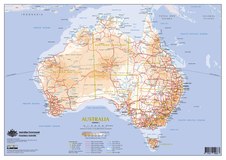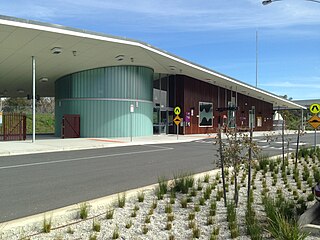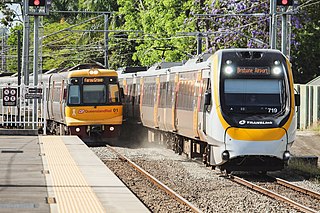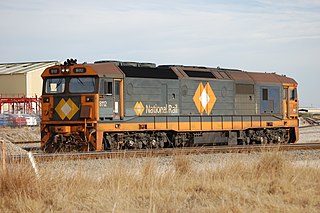Related Research Articles

There are many forms of transport in Australia. Australia is highly dependent on road transport. There are more than 300 airports with paved runways. Passenger rail transport includes widespread commuter networks in the major capital cities with more limited intercity and interstate networks. The Australian mining sector is reliant upon rail to transport its product to Australia's ports for export.

Wodonga railway station is located on the North East line in Victoria, Australia. It serves the city of Wodonga, and it opened on 25 June 2011.

Rail transport in Australia is a component of the Australian transport system. It is to a large extent state-based, as each state largely has its own operations, with the interstate network being developed ever since federation. As of 2018, the Australian rail network consists of a total of 36,064 kilometres (22,409 mi) of track built to three major track gauges: 14,814 kilometres (9,205 mi) of standard gauge ), 15,625 kilometres (9,709 mi) of broad gauge, and 4,225 kilometres (2,625 mi) of narrow gauge lines. Additionally, about 1,400 kilometres (870 mi) of 610 mm / 2 ft gauge lines support the sugar-cane industry.

Rail transport in Victoria, Australia, is provided by a number of railway operators who operate over the government-owned railway lines. The network consists of 2,357 km of Victorian broad gauge lines, and 1,912 km of standard gauge freight and interstate lines; the latter increasing with gauge conversion of the former. Historically, a few experimental 762 mm gauge lines were built, along with various private logging, mining and industrial railways. The rail network radiates from the state capital, Melbourne, with main interstate links to Sydney and to Adelaide, as well as major lines running to regional centres, upgraded as part of the Regional Fast Rail project.

The rail network in Adelaide, South Australia, consists of six lines and 89 stations, totalling 132 km. It is operated by Keolis Downer under contract from the Government of South Australia, and is part of the citywide Adelaide Metro public transport system.

Australians generally assumed in the 1850s that railways would be built by the private sector. Private companies built railways in the then colonies of Victoria, opened in 1854, and New South Wales, where the company was taken over by the government before completion in 1855, due to bankruptcy. South Australia's railways were government owned from the beginning, including a horse-drawn line opened in 1854 and a steam-powered line opened in 1856. In Victoria, the private railways were soon found not to be financially viable, and existing rail networks and their expansion were taken over by the colony. Government ownership also enabled railways to be built to promote development, even if not apparently viable in strictly financial terms. The railway systems spread from the colonial capitals, except in cases where geography dictated a choice of an alternate port.

The first railway in colonial South Australia was a horse-drawn tramway from the port of Goolwa on the Murray River to an ocean harbour at Port Elliot in 1854. Today the state has 1,600 mm broad gauge suburban railways in Adelaide, a number of country freight lines, as well as key 1,435 mm standard gauge links to other states.

The Australian Rail Track Corporation (ARTC) is an Australian Government-owned statutory corporation, established in July 1998, that manages most of Australia's interstate rail network.

The Dry Creek–Port Adelaide railway line is an eight-kilometre east–west line running through Adelaide's north-western suburbs. The line is managed by the Australian Rail Track Corporation (ARTC) and is an important link between Port Adelaide, Pelican Point and the main interstate rail routes which link Adelaide with Melbourne, Perth, Darwin and Sydney. Prior to 1988, a limited local passenger service operated, stopping at five intermediate stations along the line. Since May 1988, the line has been freight-only.
AusLink is a former Australian Government land transport funding program, that operated between June 2004 and 2009. The former program was administered by the former Department of Transport and Regional Services. In 2009, the program was replaced with the Nation Building Program under the Nation Building Program Act 2009. The Nation Building Program was administered by the Department of Infrastructure and Transport and that program was replaced by The National Land Transport Network, as determined by the Minister for Infrastructure and Regional Development under the National Land Transport Act 2014.

Rail gauges in Australia display significant variations, which has presented an extremely difficult problem for rail transport on the Australian continent for over 150 years. As of 2014, there are 11,801 kilometres (7,333 mi) of narrow-gauge railways, 17,381 kilometres (10,800 mi) of standard gauge railways and 3,221 kilometres (2,001 mi) of broad gauge railways.

The National Rail Corporation was an Australian rail operator established by the Federal, New South Wales and Victorian governments in February 1992. In February 2002, National Rail was sold to a Patrick Corporation and Toll Holdings consortium and rebranded Pacific National.

Inland Rail, also known as Inland Railway and previously Australian Inland Railway Expressway, is a 1,727-kilometre (1,073 mi) railway line under construction in Australia. Once complete, it will connect the ports of Melbourne and Brisbane along a new route west of the mountainous Great Dividing Range, bypassing the busy Sydney metropolitan area and allowing for the use of double-stacked freight trains. The route will also connect to the Sydney–Perth rail corridor, reducing journey times between Brisbane, Adelaide and Perth.

Brisbane, the capital city of the Australian state of Queensland, has a network of suburban railways that carry commuters, long-distance passengers, and freight. Suburban and interurban passenger services in Brisbane and South East Queensland are operated by the Queensland Rail City network, a branch of Queensland Rail, which operates long-distance trains across the state. Aurizon and Pacific National operate freight services.

The rail network of Melbourne, Australia, has a significant number of railway lines and yards serving freight traffic. Rail transport in Victoria is heavily focused on Melbourne, and, as a consequence, much of the state's rail freight passes through the metropolitan network.
The Western standard gauge railway line is a standard-gauge railway line in western Victoria, Australia. Completed in 1995, it forms part of the Melbourne–Adelaide rail corridor and serves as the principal interstate rail link between Victoria and the western states. The line replaced a number of former broad gauge routes which were gauge converted, and today sees both intrastate and interstate freight traffic, as well as the twice weekly The Overland passenger service. Major towns on the route include Geelong, Ararat, Horsham and Dimboola.

The Sydney–Perth rail corridor is a 1435 mmstandard gauge railway route that runs for 4352 kilometres (2704 mi) across Australia from Sydney, New South Wales, to Perth, Western Australia. Most of the route is under the control of the Australian Rail Track Corporation.
The Sydney–Melbourne rail corridor is an approximately 953-kilometre (592 mi) standard gauge railway corridor that runs between Melbourne (Victoria) and Sydney, the two largest cities in Australia. Freight and passenger services operate along the route, such as the NSW TrainLink XPT passenger service. The XPT offers a day and night service in each direction.
The Melbourne–Adelaide rail corridor is a standard-gauge railway corridor that runs 828 kilometres (514 mi) between the cities of Melbourne, Victoria and Adelaide, South Australia. Most of the current traffic is freight; the only passenger train along the entire route is the twice-weekly passenger service The Overland, operated by Journey Beyond.
The Adelaide-Port Augusta railway line is the primary rail corridor in South Australia for northbound rail traffic out of Adelaide. The line, 315 kilometres long, forms part of the Perth–Adelaide and Adelaide–Darwin rail route, and the portion south of Crystal Brook forms part of the Adelaide–Sydney rail route.
References
- ↑ "National Railway Museum Port Adelaide - Rail History". www.natrailmuseum.org.au. Archived from the original on 23 March 2008. Retrieved 30 March 2008.
- ↑ "A Critique of the Dual Gauge Link to the Port of Brisbane". www.rag.org.au. Retrieved 30 March 2008.
- ↑ Philip Laird (2001). Australia's gauge muddle and prospects. Back on Track: Rethinking Transport Policy in Australia and New Zealand. UNSW Press. p. 191. ISBN 0-86840-411-X . Retrieved 16 August 2008.